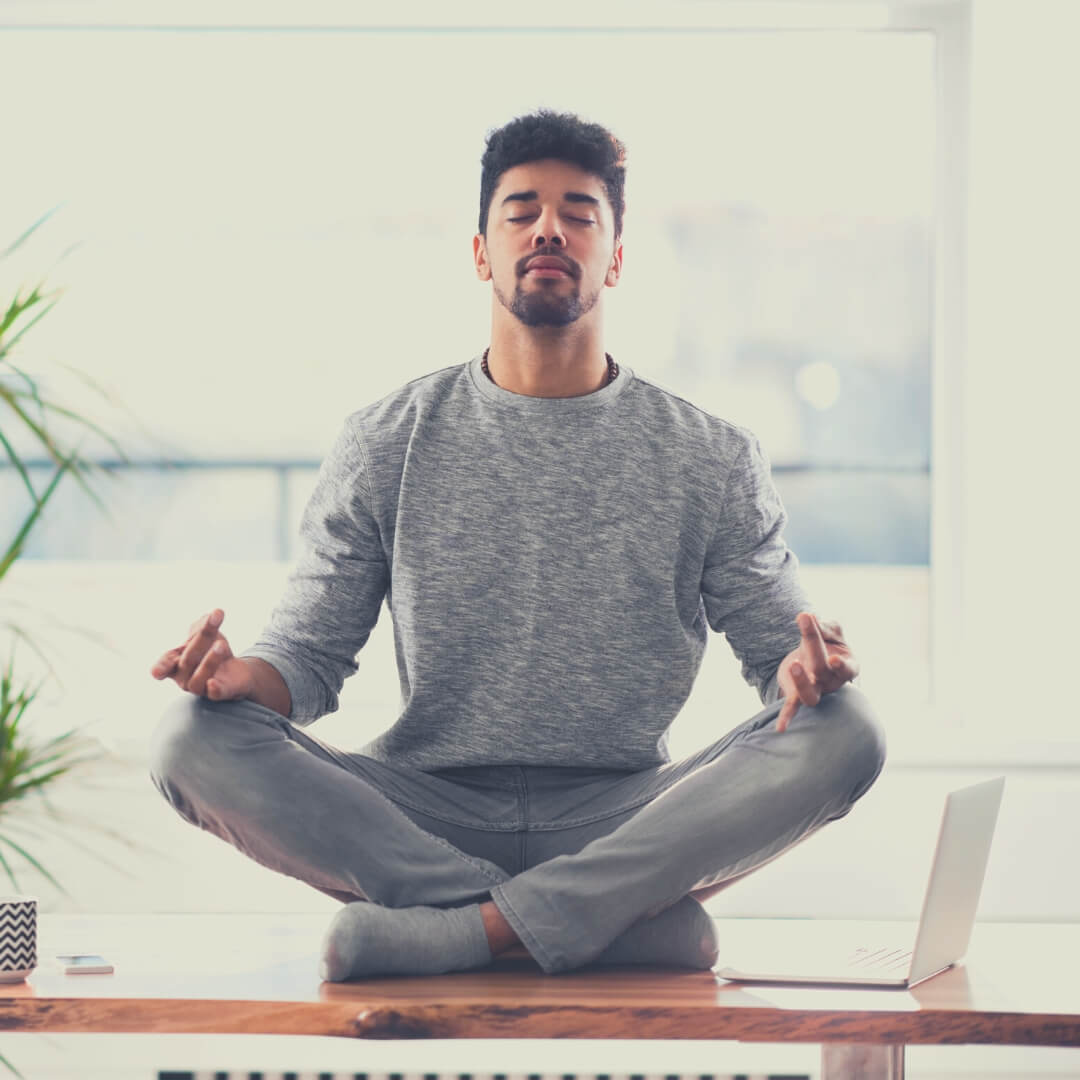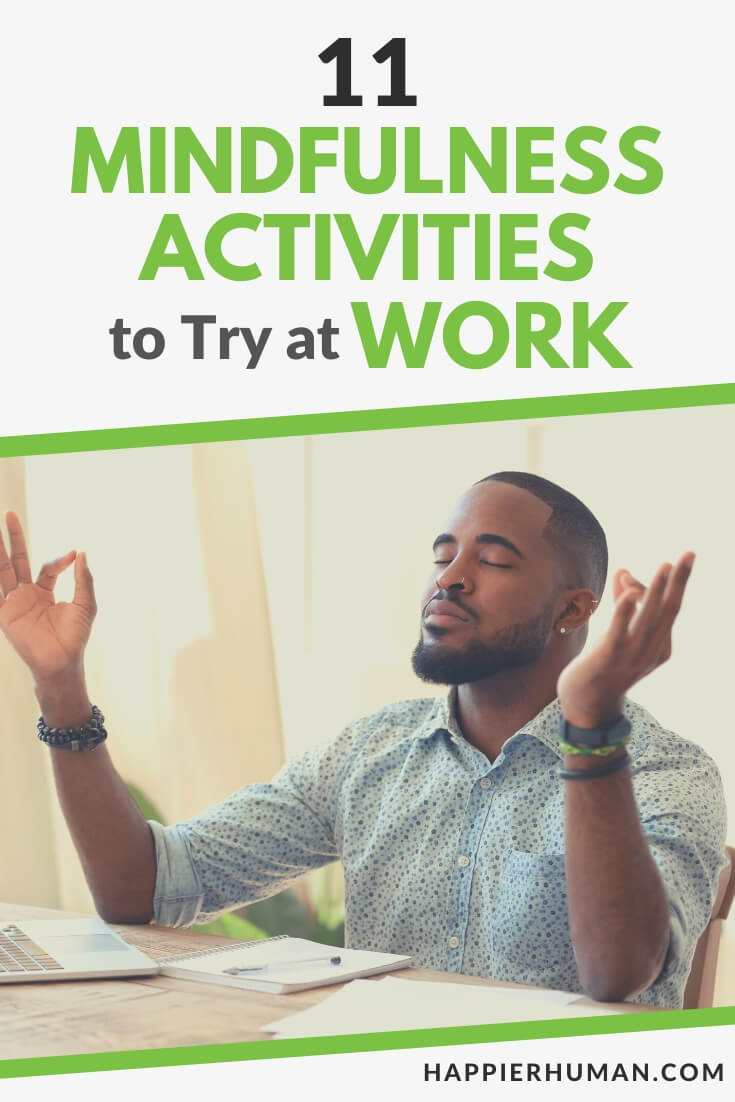There might be affiliate links on this page, which means we get a small commission of anything you buy. As an Amazon Associate we earn from qualifying purchases. Please do your own research before making any online purchase.
A colleague of mine, Abby, is going through a rough time at work. She is always on the go and she wants all her problems solved immediately.
Unfortunately, when it comes to the mind and body, there is no “quick fix.”
Are you experiencing something similar and feeling like you're running on a hamster wheel? You aren't alone. I can guarantee that if you asked a colleague how they felt right now, most would say “stressed or tired.”
How about practicing mindfulness at work and paving the way for a more relaxed and mindful approach to your day? You won’t regret it.
A little goes a long way and this guide will help take you (and your colleagues) on a journey of self-awareness.
What Are Mindfulness Activities?
Mindfulness activities help us find grounding in our everyday lives. It teaches us to be present in the here and now, by drawing our attention to what is happening around, and within ourselves. It gives us the tools to put away thoughts about the past and future.
Above all, practicing mindfulness will help you deal with situations better without judgment or criticism.

All the activities in this guide include guided imagery, breathing methods, and techniques to help you reach a place of calm acceptance for any situation you face.
Benefits of Mindfulness
Mindfulness at work will help you slow down for a moment and really take it all in. You'll learn to acknowledge what your body and mind are feeling without trying to control or overthink the situation.
Take a look at the fantastic benefits of practicing mindfulness at work:
11 Mindfulness at Work Activities
Here are 11 mindfulness activities you can try at work:
1. Wake-up Mindfulness Meditation (Gökotta)
Starting your day with mindful meditation will positively impact how you deal with situations and moments at your workplace. Gökotta is a Swedish word that means waking up early and listening to birdsong and nature.
Set yourself an alarm; even if you only wake up 15 minutes earlier than usual, your body and mind will thank you.
The beauty of this activity is that you can stay in bed while practicing this morning routine.
Your body is still in the process of waking up and is well rested. Before we jump into the steps, take a moment to run through 3 to 5 things you’re grateful for this morning.
Steps for a wake-up meditation:
1. Keep your eyes closed and notice the calm thumping of your heartbeat. Feel how your chest moves as you breathe in and out. Take this moment to connect fully with your body and mind.
2. Empty your mind of any thoughts that concern work. This is your time now. Be mindful of where you let your mind wander. Enjoy this moment and listen to the beautiful sounds around you.
3. When you’re ready, raise your arms over your head and enjoy a long stretch as you point your toes toward the end of your bed.
4. Sit up and wrap your arms around yourself in a warm embrace. You’ve got this. Now you’re ready to start the day.
2. Drop an Anchor
I am sure you'll agree with me when I say that working with a group of people can become overwhelming. You're all individuals with unique outlooks, work ethics, and feelings. Sometimes things can become tense, and you may become irritated or frustrated with another colleague.
In these moments, you need to say “Woah, this feeling is taking over, and I just need some time to process the situation.” Your colleague has just as much right as you to feel the way they do.
So take a deep breath and drop an anchor.
Steps for dropping an anchor:
1. Remove yourself from the situation and find a quiet spot in your office to sit. Take a few deep breaths and acknowledge your feelings. Breathe through them and accept them. This is just a feeling; feelings can get jumbled up in moments of stress or anxiety.
2. Imagine an anchor holding you steady through a turbulent sea. Let it bring you back to the present. Try not to attach negative connotations or experiences to this moment. You must also be mindful of your colleagues' feelings.
3. Once you feel calm and ready, you can sit down with your colleague and find a solution that suits you both. Anchoring yourself helps you think rationally.
3. The Breathing Daisy
Rushing around at work and trying to meet deadlines is one of everybody’s biggest distractions from mindfulness. Realizing you forgot to make that phone call leaves you with a sinking feeling in your stomach, and without realizing it, you're holding your breath.
Suddenly, you're anxious and breathing far too quickly. This is where the breathing daisy technique is useful at the office. This technique will help you take control of your breath and help you focus on bringing your mind back to a state of calmness.
Steps for the breathing daisy:
1. Sit comfortably in your office chair and lean back slightly. Allow your hands to rest gently in your lap as you acknowledge your feelings, and take a long healthy breath. Focus on your breath as you breathe through your nose, and slowly release the breath out through your mouth.
2. Now close your eyes and picture yourself smelling a daisy (or any flower you love). Slowly take a deep breath through your nose and imagine the calming scent of your flower.
3. Hold your breath for a moment, and release all those anxious feelings on the exhale. Try to picture yourself blowing the petals off your daisy as you do this. Repeat these steps until you feel a sense of calm wash over you.
4. Mindful Listening
In a world that’s so technologically driven, it can be so challenging to put your phone down and really give another person your full attention. Mindful listening is an effective way to connect with the here and now.

Be mindful of the other person and give them one of the greatest gifts: your time and attention. The workplace is the perfect place to do this activity. Sit one-on-one with a colleague or as a group at snack time (for example).
Steps for mindful listening:
1. Sit down with your colleague and encourage them to tell you about their day. Keep eye contact, and don’t let your eyes wander around the room. This shows disinterest or boredom. Really focus on what they’re telling you.
2. Keep your body language relaxed and open. Sit comfortably and try not to fidget. Use gentle gestures to agree or disagree with your colleague. Avoid interrupting them when they’re speaking.
3. Remember, this activity is mindful listening, not talking. We are eager to tell our side of a story or experience, but mindfulness requires focus and being present in the moment. You may learn something new from your colleague that you can apply in your life.
5. Check-in with Yourself
It's been a long day, and you need to check in with yourself. Make sure you are doing okay and that you feel calm and fulfilled. You can check in with yourself multiple times a day. I do a quick scan at least twice a day.
Why not invite a colleague to join you over your lunch break? A check-in (also known as a body scan) can take as little as 10 minutes. Otherwise, you can check in with yourself when you have a quiet moment at your desk.
Steps for checking in with yourself :
1. Relax your body completely and close your eyes. Imagine yourself as a rag doll. There's no resistance or tension in your body. Inhale through your nose and exhale through your mouth.
2. Sink deeper into this weightless sensation. There is no judgment here. Allow your breathing to slow down as you focus on your toes, and acknowledge them by wiggling them gently. Move your thoughts to your tummy. Release any feelings of tightness or anxiousness. Be present and thank your body for its hard work.
3. If your mind begins to wander, draw it back to your breath. Check-in with your chest, arms, and hands. Wiggle your fingers slowly. Release any tension in your shoulders, neck, and jaw as you breathe through the sensations.
4. Focus on letting go of any stress bottled up in your head and mind. Take a deep breath and focus on pouring love and positive affirmations into your whole body. When you're ready, slowly return your thoughts to the room.
6. Desk Yoga Stretches
Working at a desk all day and staring at a computer screen can be pretty painful for your body and mind. It’s so important to acknowledge when you need a break. Why not do some mindful yoga stretching right here at your desk?
And no, it’s nothing like the complicated and awkward moves you see on TV. There are actually several desk-friendly stretches available. This guide will concentrate on two awesome stretches to help you become more mindful and release stress.
Steps for desk yoga stretches:
1. Cat-cow stretch: Sit comfortably in your chair and keep both feet flat on the floor while placing your hands lightly on your knees. As you inhale, arch your back and look at the ceiling.
As you exhale, round your spine and drop your head toward the floor. Repeat this flow 3 to 5 times. This pose relieves tension in your neck, shoulders, and upper back.
2. Wrist stretch: Stand up and place your hands on your desk. Turn your hands so the insides of your wrists face your screen. Your fingers must face the edge of your desk. Gently lean away from your desk while flattening your palms as much as possible.
Inhale and exhale slowly while the tension and stress slowly melt away from your body.
7. Mindfulness at Teatime
Life makes more sense with a cup of tea (or coffee). In my work experience, there isn't much that a steaming cup of tea can't fix. But it's not actually the tea itself that fixes our problems; instead, it's the process and the distraction of making that hot cuppa.
A cup of tea can be enjoyed on your own or with a group of colleagues. It's a wonderful way to check in with yourself and others. Find a quiet place to sit down and chat.
Steps for teatime:
1. Take your time while brewing your tea and watch the tea bag change the water's color.
2. Inhale the smell of the brewing tea as you repeat some positive affirmations to yourself. Exhale as you release any built-up tension in your body.
3. Join your colleague and slowly sip your tea as you enjoy a chat. Talk softly and gently, and enjoy any quiet moments between you.
8. Mindfulness Jar
Do you ever feel like your workload keeps piling up, the phones won't stop ringing, and your boss wants feedback on a project? Yeah, same here. These situations can put our minds and bodies under tremendous stress, and then we lose focus and battle to get anything done.
Make yourself a mindfulness jar for your desk. Fill your jar with about ¾ water and add clear glue, food coloring, and glitter (or mica powder) to the water. I glued a precious stone to the lid on the inside of mine for a focus point.
Tighten the lid carefully and ensure there are no bubbles. Easy peasy, and it looks gorgeous on your desk. You can also use this jar when you feel like you just need a break, when you want to empty your mind and relax.
Steps for a mindfulness jar:
1. When you feel overwhelmed, pick up your jar and give it a vigorous shake. Place it back on your desk and watch the glitter swirl inside the jar. Focus on taking long, deep breaths.
Your mind is like the jar. You have so many emotions swirling around that you can’t see a way through.
2. Watch how the glitter calms down and settles on the bottom of your jar. Did you notice you didn’t have to do anything to calm the glitter down? You took a moment, sat still, and observed. Everything was okay.
3. Focus on your precious stone and breathe in calmness and exhale stress. By sitting still, you focus on your next move (so you don’t just fly off the handle and you realize that things aren’t as bad as they first seemed to be). You didn’t allow your emotions to take control.
9. Mindful Hand Massage
Our hands really do a lot for us. They allow us to complete work and connect with other people. They even help us express our emotions. So it’s essential to take good care of our hands, especially in the work environment.

Doing a mindful hand massage at your desk is a great self-care activity that helps you to slow down from your busy day, soothe an uncomfortable moment or ease any pain from typing (for example).
A mindful hand massage also encourages you to touch base with the rest of your body and mind.
Steps for mindful hand massaging:
1. Sit in a relaxed position with both feet on the ground (you can also lean back a little if you want). Close your eyes and take a deep breath, slowly exhale and study your hands for a moment.
2. Rub your hands together until they feel warm, and allow that warmth to flow through your body. Remember to keep your eyes closed.
3. Massage the tips of your fingers and your palm to your wrists. Repeat on the opposite hand. Rub and warm your hands up again while breathing in and out slowly.
4. Place your warm hands gently on your face and concentrate on your eyes and temples. The warmth will help you relax.
10. Chill-out Cards
Sharing mindfulness activities with your colleagues is a fantastic way to take time out and bond with one another. These mindful chill-out activity cards are excellent for using mindfulness techniques in your everyday life.
Mindfulness takes repetition, and these cards will give you the necessary prompts. Decorate a colorful box to put your cards into and place it somewhere in the office where everyone can access them when they need a mindful moment.
Steps for making chill-out cards:
1. Make your pack of mindful cards using colored cardboard and pens. Another option is to type them out and get them printed.
2. Write fun activities, prompts, and questions on the cards to encourage your colleagues to slow down and be mindful. Ensure the activities are quick and fun, as you are still on the clock.
A few suggestions for your mindfulness cards:
-> Share 3 things you’re happy about.
-> Keep your eyes closed and focus on your breathing.
-> Strike a random yoga pose.
-> Give yourself a head massage.
-> Place your hands on your tummy. What do you feel?
-> Look at all the little details on your hands.
3. Take turns drawing cards and following the prompts.
11. Shake It Off
Practicing mindful activities in your workplace is a wonderful way to deal with stressful situations. Unfortunately, there will be bad moments, hours, or mornings along the way (and that's okay).
The trick is not to let your feelings snowball into a situation far bigger than it really is. If you're a Taylor Swift fan, then she's got the right idea with her song “Shake It Off.”
Steps for shaking it off:
1. Stand at your desk and let your arms hang at your side. Inhale slowly through your nose and exhale through your mouth. Focus on your breath and heartbeat. Picture a bad moment sitting on your shoulders. Own it for what it is, and leave it there for now.
2. Raise your right shoulder and drop your left shoulder toward the ground. Imagine that bad moment slipping to the ground along with all those anxious feelings. Repeat on the other side.
3. Picture all your stress and negativity crashing to the floor as you shake this bad moment off. Take a few deep breaths and return to work with a happier heart.
Final Thoughts on Mindfulness at Work
In a world fueled by instant gratification and people always searching for “a quick fix”, mindfulness is often on the back burner (or, worse, forgotten). The workplace is sadly no exception.
Employers and employees are obsessed with getting the job done as quickly and efficiently as possible. While efficiency is a good thing, is it worth burnout?
This is why mindfulness is so important in a work setting. After all, we spend most of our day at work and want that time to be well spent.
The practice of mindfulness doesn’t have to stop there… it should carry over into your home life too. Everyone will be happier for it. Trust me. You can check out some more mindful activities to use in your everyday life by reading our guide to mindfulness group activities.
Read More about Mindfulness:
- 11 Mindfulness Blogs to Create Inner Peace
- 50 Positive Affirmations for Success at Work
- 11 Best Gifts for Mindfulness Practitioners
- 6 Authentic Ways to Deal with Social Anxiety in ANY Situation
Finally, if you want a simple way to reduce your stress and anxiety, then try writing these 35 mindfulness journaling prompts to live more in the present moment.


